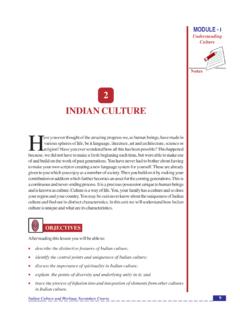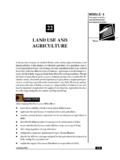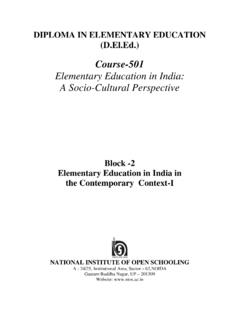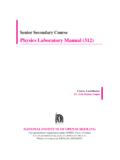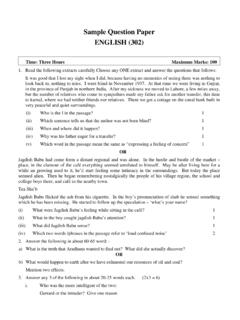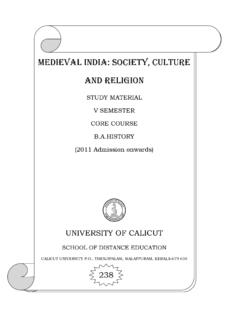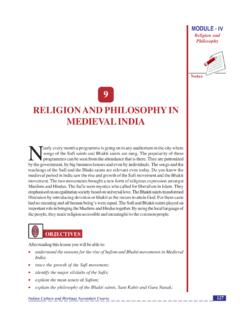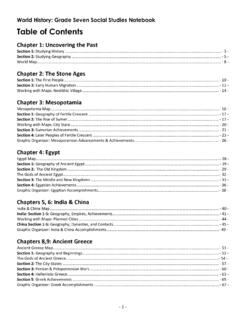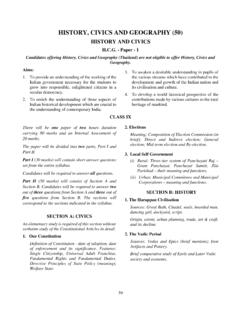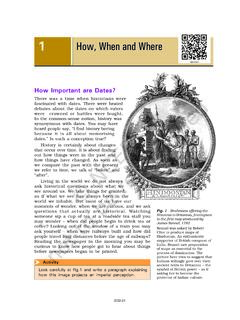Transcription of 4 MEDIEVAL INDIA D
1 MEDIEVAL IndiaNotesIndian culture and Heritage Secondary Course 44 MODULE - IIHistory andCulture throughthe Ages4 MEDIEVAL INDIAD evelopments in the field of religion, folk art and language in INDIA during the medievaltimes have been important milestones in the evolution of the composite culture ofIndia. New religions movements like Sufi and Sikhism along with Bhakti movementcontributed to this process. If you look around, you will see the impact of Islam on manyaspects of Indian culture . You might have visited some famous monuments in INDIA . Thesemonuments stand as the symbols of the composite nature of Indo-Islamic culture in can also see how various religions in INDIA , including Islam, have influenced eachother. Besides, every region in INDIA is famous for giving shape to some folk art or theother. Development of folk arts through which the common people display their creativityis another significant aspect of Indian culture . The various regional languages that we speaktoday too have an interesting history which evolved during this period.
2 OBJECTIVESA fter reading this lesson you will be able to : understand society during MEDIEVAL times; trace the rise of Islam and Sufism; describe the political situation of INDIA in MEDIEVAL times; examine the influence of Islam on Indian religion; trace the growth of the Bhakti movement; examine the development of folk arts, painting and music during the MEDIEVAL period; trace the rise of modern Indian languages; MEDIEVAL IndiaNotes 45 Indian culture and Heritage Secondary CourseMODULE - IIHistory andCulture throughthe Ages discuss the rise of Sikhism and the Sikh power in INDIA ; and trace the developments in South INDIA . LIFE OF PEOPLE UNDER DELHI SULTANATEWhen the Muslim invaders came to INDIA they decided to make it their home. They inter-married and took to the culture of the Indians. There was a mutual exchange in ideas andcustoms. In dress, speech, manners and intellectual outlook, the two influenced each othervery profoundly. Some of these changes are described Indian society was divided into four major groups.
3 They were the aristrocats, thepriests, the towns people and the aristocrats included the Sultan and his relatives, nobility and the landholders. Therewere also the Hindu rajahs, chiefs, Hindu merchants and bankers. They concentrated allthe wealth as well as the power in their hands. Needless to say that they were a group ofvery powerful people. They lived in great style and luxury. The Sultan outmatched everyonein this. He had to do it so as to maintain his superiority and his status. He had to show thathe was different from the others. Whenever a new sultan came to the throne, the Khutbaor sermon was read out in his name in the Friday prayers at the mosques and coins wereissued in his name. This established the new ruler on the throne. To maintain his distincionas the ruler, he was provided with many officers and servants at the royal household wherehe lived in great luxury. Even the nobility imitated his style and showed off their PriestsThe Priests were another important class of people in the society.
4 Among the Hindus, theywere the Brahmans and Ulemas among the Muslims. They were given grants of tax-freeland for their maintenance and were often very powerful. The Ulemas wielded great influenceon the Muslim Sultans and often influcenced their policies. But at other times like duringthe reign of Ala-ud-din Khalji, they were even ignored. Sometimes the priests were notinterested in religious affairs but were more interested in worldly Town PeopleIn the town lived the wealthy merchants, traders and artisans. The nobility, the officers andthe soldiers also stayed in the towns, that were the administrative and military where the Sufi and Bhakti saints lived and places which housed important templesand mosques had become pilgrim centres. The artisans lived in their own special IndiaNotesIndian culture and Heritage Secondary Course 46 MODULE - IIHistory andCulture throughthe AgesIn fact, the weavers lived in the weaver s colony, the goldsmith lived in a colony inhabitedby goldsmiths and so on.
5 This was the general pattern for all artisans and craftsmen. Thesepeopole supplied luxury goods were also sent abroad for trade. The royal karkhanas orworkshops employed these workers for producing beautiful goods which were often usedas gifts to be given away by the PeasantsThe peasants, of course, lived in the villages and were often the worst off. They paid hugetaxes to the state as land revenue. Any change of dynasty had no effect on their lives. Theirlife continued as caste system was very rigid and intercaste marriages and intercaste dining was totallyprohibited. But exchange of ideas did take place on a large scale. Those who convertedthemselves to Islam did not forget their old customs. Thus, exchange of ideas and customstook place. Many Hindu customs were adopted by the Muslims while many Muslim customswere adopted by the Hindus, like those concerning food, dress, clothing and music, besidesmany was flourishing and many new towns came up to encourage trade. Some communitieslike the Banias, Marwaris and Multanis made trade their special vocation.
6 The banjarastraded in caravans and were continuoulsy on the move carrying goods from one place was the centre for the incoming as well as outgoing goods. There was rice from theEast, sugar from Kanauj, wheat from the Doab and fine silks from the South. Besides,there were luxury goods like metalware, ivory, jewellery, cotton textiles and many from outside INDIA like East Africa, Arabia and China also came to Delhi. Accordingto Ibn Batuta, Delhi at that time was a magnificent growth of trade encouraged the use of money and at this time came into use the silvertanka (coin). It was the most commonly used currency and was introduced by the system of weights, that were used at that time, continued to be in use until therecent adoption of the metric ConditionWhen Islam came to INDIA , Hinduism was in vogue. But by this time Hinduism haddegenerated itself. There were superstitious beliefs, rituals and sacrifices. Brahmans hadbecome very powerful and the caste system was very rigid. The people, especially thelower classes, were ill-treated.
7 Islam was the opposite of what was in practise among theHindus. It talked of equality, brotherhood and oneness of God. There were no dogmas inIslam. On the other hand, it had a simple doctrine and a democratic IndiaNotes 47 Indian culture and Heritage Secondary CourseMODULE - IIHistory andCulture throughthe AgesThe coming of Islam did not bring in many changes in the political structure of the the other hand, it challenged the social pattern of society. The important result of thiscontact was the emergence of the Bhakti movement and the Sufi movement. Both themovements were based on the fact that God was supreme, all men were equal for Himand Bhakti or devotion to Him was the way to achieve salvation. RISE OF ISLAM AND SUFISMThe Muslims first came to INDIA in the eighth century AD mainly as traders. They werefascinated by the socio-cultural scenario in this country and decided to make INDIA theirhome. The traders who came to INDIA from Central and West Asia carried back with themtraces of Indian science and culture .
8 As a result they became cultural ambassadors of Indiaby disseminating this knowledge to the Islamic world and from there to Europe. Theimmigrant Muslims also entered into matrimonial alliances with the local people and learnedto live together in harmony. There was mutual exchange of ideas and customs. The Hindusand Muslims influenced each other equally in dress, speech, manners, customs and intellectualpursuits. The Muslims also brought with them their religion, Islam which had a deep impacton Indian society and culture . Let us find out more about Prophet Mohammad and Islamin this Mohammad preached Islam in the seventh century AD in Arabia. He was born inAD 5 71 in the Quraysh tribe of Arabia. He migrated to Madina from Mecca in AD 622and this marked the beginning of the Hijira Era. According-to the Muslim belief, Quran isthe message of Allah revealed to Mohammad through his archangel Gabriel. It has beentranslated into several five fundamental principles of Islam are:(1) Tauhid (belief in Allah)(2) Namaz (prayers, five times a day)(3) Roza (fasting in the month of Ramzan)(4) Zakat (giving of alms)(5) Haj (pilgrimage to Mecca)Prophet Mohammad s sayings are preserved in what is called the Hadith or Hadees.
9 Afterhis death the Caliphate was established. There were four pious talked of equality, brotherhood, and the existence of one God. Its arrival particularlymade a profound impact on the traditional pattern of Indian society. The rise of both theBhakti and the Sufi movements contributed immensely in this regard. Both the Bhakti andthe Sufi movements believed that all humans are equal, God is supreme and devotion toGod is the only way to achieve IndiaNotesIndian culture and Heritage Secondary Course 48 MODULE - IIHistory andCulture throughthe Ages Rise of SufismSufism is a common term used for Islamic mysticism. The Sufis were very liberal in theirreligious outlook. They believed in the essential unity of all religions. They preached spiritualitythrough music and doctrines that professed union with God. Sufism originated in Iran andfound a congenial atmosphere in INDIA under the Turkish rule. Their sense of piety, tolerance,sympathy, concept of equality and friendly attitude attracted many Hindus, mostly fromlower classes, to Islam.
10 Sufi saints such as Moinuddin Chisti, Nizamuddin Auliya, FariduddinGanj-e-Shakar were the pioneer suf s who are still loved, respected and honoured inIndia. The sufis were also influenced by the Christian and Buddhist monks regarding theestablishment of their khanqahs and dargahs. Khanqah the institutions (abode of Sufis)set up by the Sufis in northern INDIA took Islam deeper into the countryside. Mazars(tombs) and Takias (resting places of Muslim saints) also became the centres for thepropagation of Islamic ideas. These were patronized both by the aristocracy and thecommon people. The Sufis emphasized respect for all human Sufis were organised into religious orders or silsilahs. These silsilahs were namedafter their founders such as Chishti, Suhrawardi, Qadi. and Naqshbandis. According toAbul Fazl, the author of the Ain-i-Akbari, there were as many as fourteen silsilahs inIndia during the sixteenth century. Each order had its own khanqah, which served as ashelter for the Sufi saints and for destitutes, and later developed as a centre of , Nagaur and Ajodhan or Pak Pattan (now in Pakistan) developed as importantcentres of Sufism.
